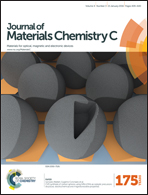Structural evolution, photoinduced energy transfer in Au nanocluster–CdTe QD nanocomposites and amino acid sensing†
Abstract
Metal–semiconductor heterostructures/composites are found to be a new class of functional materials because of their unprecedented properties and potential applications. Various strategies have been adopted to design such materials with unique properties. Here, we have synthesized Au–CdTe nanocomposites using Au nanoclusters, and the growth rate is controlled by changing the Au : Cd ratio. The structural characterization of Au–CdTe nanocomposites is done by SAXS (small angle X-ray scattering), TEM (transmission electron microscopy), X-ray photoelectron spectroscopy (XPS), FTIR (Fourier transformed infrared), and steady state and time resolved spectroscopy. The blue shifting of the absorption band of CdTe QDs and strong photoluminescence quenching in the presence of Au suggest the metal cluster–semiconductor composite formation. A time resolved spectroscopy study confirms the Förster resonance energy transfer from QDs to proximal Au nanoclusters by changing the non-radiative decay rate. Interestingly, turn on of the signal i.e. the enhancement of photoluminescence (PL) intensity of the nanocomposite is observed in the presence of amino acid and the limit of detection (LOD) for L-cystein amino acid is found to be 192 nM. These nanocomposites open up new platforms to design optical based probes for selective sensing of amino acids.


 Please wait while we load your content...
Please wait while we load your content...